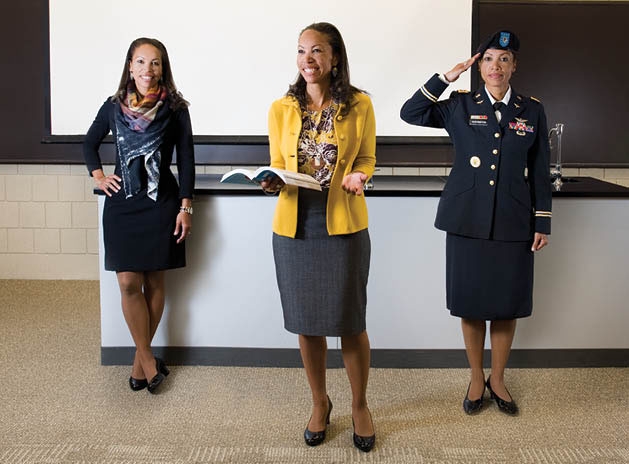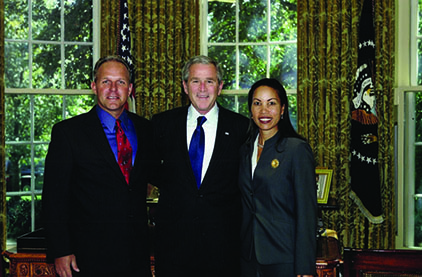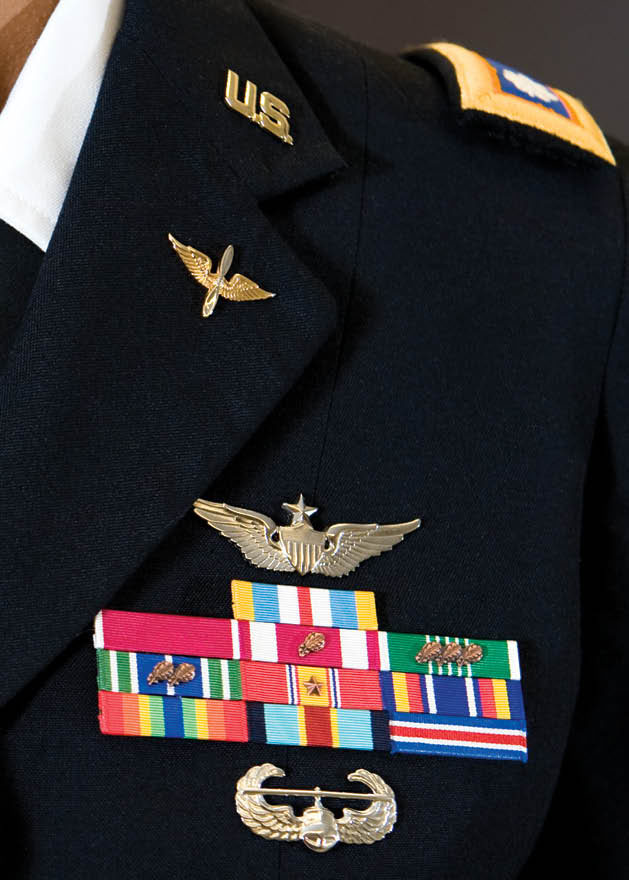
Miki Huntington has worked in the White House. She’s flown Black Hawk helicopters. She has lived overseas. She spent 25 years in the U.S. Army. She served as a member of President George W. Bush’s administration. And though she’s already achieved that prestigious list of accomplishments, Huntington is now living in Excelsior, tackling another item on her bucket list: teaching.
Huntington was born in Japan, where her father, retired by that time, had been stationed with the Navy. Her family lived in Japan until Huntington was 10. It was overseas that she developed a deep appreciation for her country, and she eventually joined the Reserves and then ROTC to help pay for an education degree.
As she listed her preferred areas of military service, aviation came to mind. “Someone told me not to put it down,” says Huntington. “ ‘You’ll never get it,’ they told me… but sometimes a challenge is a really great motivator!” That spirit of confidence and resilience is one that’s served Huntington well through 25 years in the Army, including 10 as a pilot in Huey and Black Hawk helicopters.
Along the way, she earned a master’s degree in Asian studies, lived in South Korea and Japan, and became foreign area officer for Asia and the Middle East. When Huntington was asked to apply for a position at the White House, she and her husband knew they couldn’t pass up the opportunity. So she spent 2007 through 2009 in Vice President Dick Cheney’s National Security Affairs Office.
In 2011, she retired from her final military position as the chief of U.S.-Japan government relations, and she and her husband, an Excelsior native she met in South Korea, decided to move back to the lake area. She began pursuing her life-long dream of teaching, and she brought her extensive military and travel background into the classroom as a political science professor at Minneapolis Community and Technical College (MCTC). She also advises MCTC’s Student Veterans of America (SVA) chapter and is co-chair of MCTC’s branch of Beyond the Yellow Ribbon (BTYR). It’s an initiative that connects veterans with support, training and resources; Huntington and her team plan events and coordinate resources designed to raise awareness of and build support for veterans and their families.
Annette Kuyper is director of military outreach for the Minnesota Department of Military Affairs, and she’s worked closely with Huntington to develop MCTC’s Beyond the Yellow Ribbon program.
“Veterans need to feel like they can come back and contribute in their civilian communities,” says Kuyper. “We’re educating our networks on the resources that are available, making more people aware of resources in case transitional issues surface.” Though raising awareness in a community is important, “it takes people like Miki to lead organizations and synchronize support,” says Kuyper.
Huntington worked with Kuyper to secure MCTC’s certification as a recognized Yellow Ribbon Company, which included making an organization-wide commitment to supporting veterans and military-connected families and community members. In January, MCTC became one of 47 Yellow Ribbon organizations in Minnesota.
Kuyper notes that a recent Readiness & Resilience in National Guard Soldiers (RINGS) study found that combat service members are amazingly resilient. “Key factors that help in that resiliency are that they came back to communities and workplaces and educational institutions that show acceptance and visible support for veterans,” says Kuyper.
Tara Martinez, director of student life and co-chair of the Yellow Ribbon Committee at MCTC, notes that being a veteran is different from other identities.
“It’s not an identity that’s often obvious … veterans might not easily connect with each other,” says Martinez. The Yellow Ribbon Committee developed a Hall of Veterans designed to commemorate service members in the current MCTC community. In this way, students and staff could begin to recognize and support MCTC veterans and active service members.
“As someone who hasn’t served in the military, I needed to partner with someone who had. Miki is poised, polished and professional, but also so fun and down-to-earth,” says Martinez. She notes that MCTC has a student population with an average age of 28, so there’s a higher-than-average percentage of veterans and non-traditional students. Huntington offers her military background every day in the classroom, but also knows first-hand that just as college experiences are diverse, a military background isn’t the same for everyone.
“I wasn’t a combat veteran. For some of us, going to work in the military is just like going to a regular job. Yes, there are serious needs we need to address [for combat veterans], but that wasn’t the experience for all of us,” says Huntington. More importantly, she says, communities need to recognize the wide variety of reactions and needs of our veterans, and to offer support and understanding.
One aim of Beyond the Yellow Ribbon is simply to be more inclusive and appreciative of veterans in our communities. Huntington says that the Yellow Ribbon initiative at MCTC has encouraged her because “it’s taken the conversation beyond ‘Thank you for your service.’ Not to discount the intent behind that comment, but it’s just the start of the conversation.”
Though it’s taken her a few extra years to land her original dream job in the classroom, Huntington says that working with students isn’t all that different from her time in the military. Says Huntington, “Service in a uniform, or service in the classroom… I’m grateful to do what I do.”


(Photos courtesy of Miki Huntington)
Taking Flight
Far left: Miki Huntington in a UH-1 “Huey” Iroquois helicopter at K-16 Seoul Airbase. Top center: Huntington’s husband David, left, and Vice President Dick Cheney, right, pin on Huntington’s new rank of Lieutenant Colonel during her promotion ceremony in 2008. Bottom center: David and Miki Huntington with President George W. Bush in the Oval Office in 2009.
Yellow Ribbon
Miki Huntington works with Minneapolis Community and Technical College’s student veterans’ groups and helped secure the college’s certification as a Yellow Ribbon Company.
Decorated
Learn about some of the awards on Miki Huntington’s uniform.
Senior Aviator Badge (silver wings) Awarded for attaining an aeronautical rating of Senior Army aviator; recipients have at least 1,000 hours and 84 months of Department of Defense (DOD) aviator flight time, which must include flight time as a pilot in command. Huntington piloted UH-1 “Huey” Iroquois and UH-60 “Black Hawk” helicopters.
Defense Superior Service Medal Awarded to members of the Armed Forces who rendered superior meritorious service in a position of significant responsibility. Huntington received the award upon completion of her White House assignment.
Legion of Merit Awarded to any member of the Armed Forces who has distinguished himself or herself by exceptionally meritorious conduct in the performance of outstanding services and achievements. Huntington received the award upon her retirement following 25 years of service in the Army.
Meritorious Service Medal (one bronze oak leaf cluster) Awarded to any member of the Armed Forces who has distinguished himself or herself by outstanding meritorious achievement or service. The oak leaf cluster is issued to denote the award of second and succeeding decorations.
Army Commendation Medal (three oak leaf clusters) Awarded to any member who distinguishes himself or herself by heroism, meritorious achievement, or meritorious service.
Army Achievement Medal (two oak leaf clusters) Awarded to any member who distinguishes himself or herself by meritorious service or achievement of a lesser degree than required for award of the Army Commendation Medal.
National Defense Service Medal (one bronze star) Awarded for honorable active service for any period between 2 August 1990 and 30 November 1995 (Persian Gulf) and 11 September 2001 to a date to be determined (Global War on Terrorism). The bronze service star is worn to denote participation in a named campaign to denote an additional award. Huntington notes that she did not deploy overseas to Iraq or Afghanistan, so this medal simply reflects her service during the specific time period.
Global War on Terrorism Service Medal Awarded to members of the Armed Forces who have participated in or served in support of a Global War on Terrorism operations outside of the designated area of eligibility on or after September 11, 2001 to a future date to be determined.
Army Service Ribbon Awarded to members of the U.S. Army for successful completion of initial entry ("basic") training.
Army Overseas Service Ribbon Awarded to members of the U.S. Army for successful completion of overseas tours.
Reserve Components Overseas Service Ribbon Awarded to members of the Reserve Components of the Army for successful completion of annual training or Active Duty Training for a period of not less than 10 consecutive duty days on foreign soil.
Air Assault Badge (silver badge) Eligibility criteria consists of satisfactory completion of an air assault training course.










